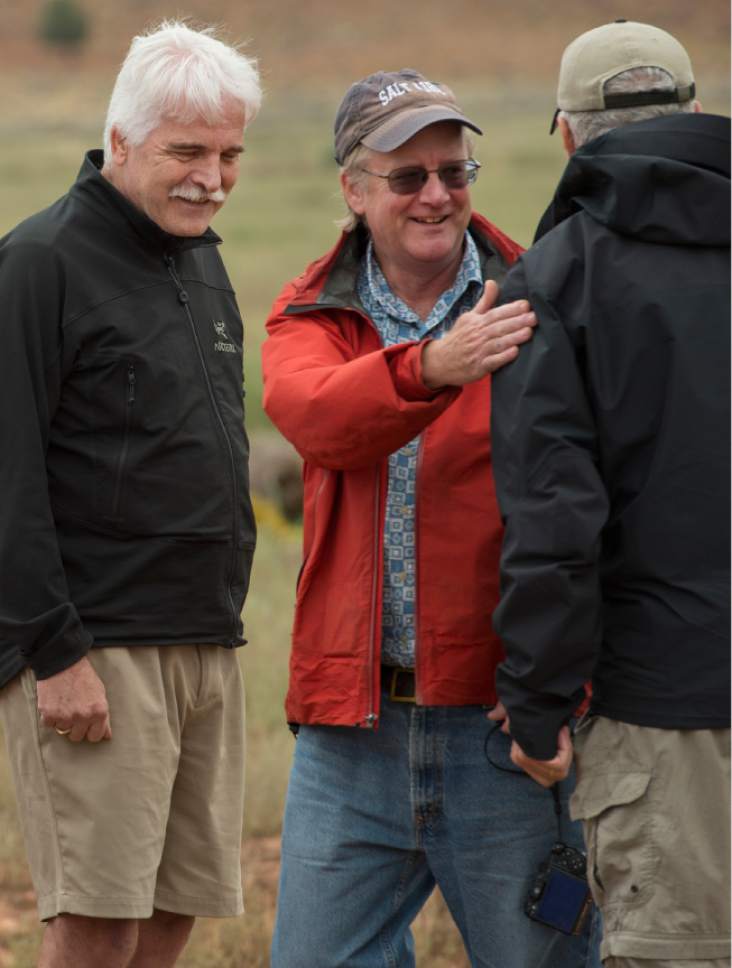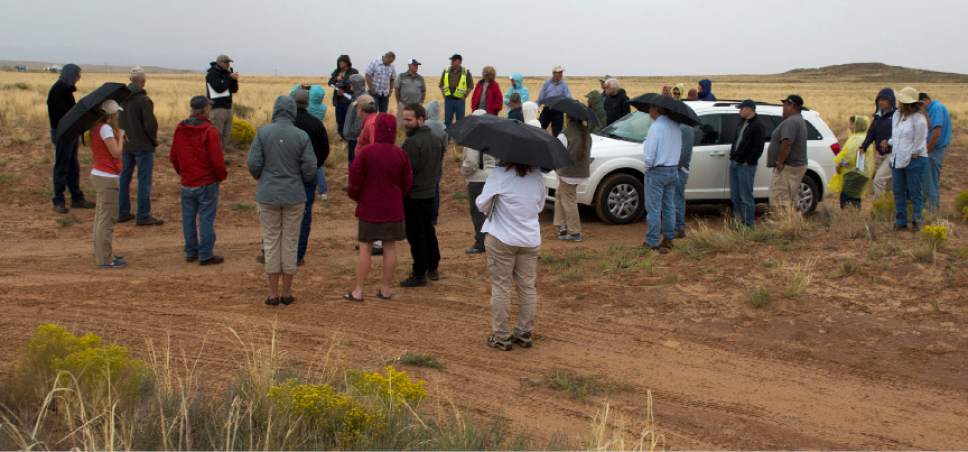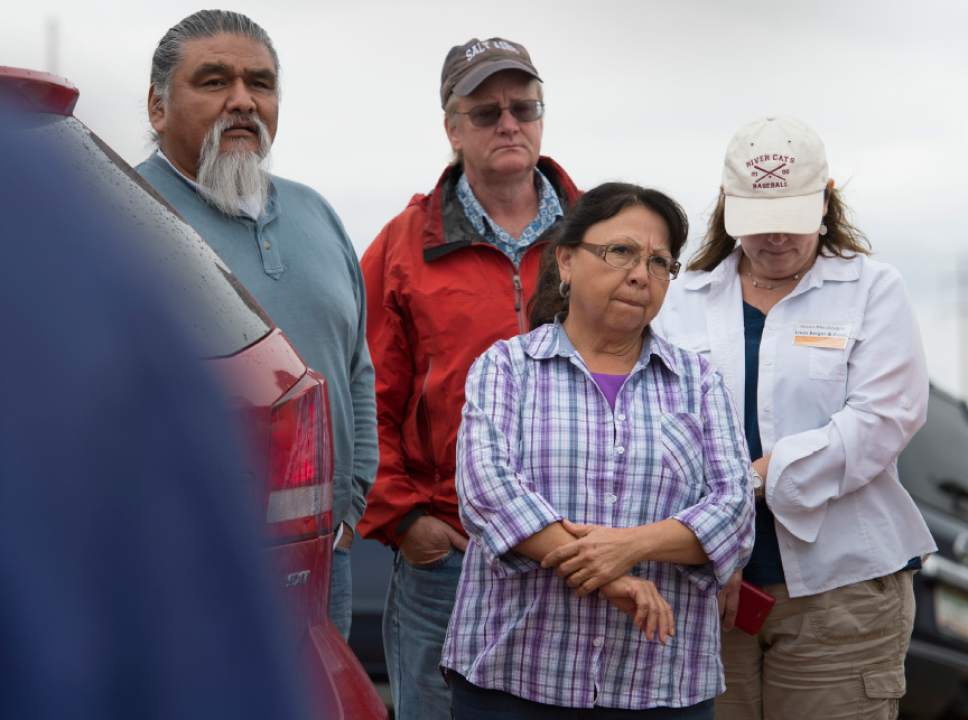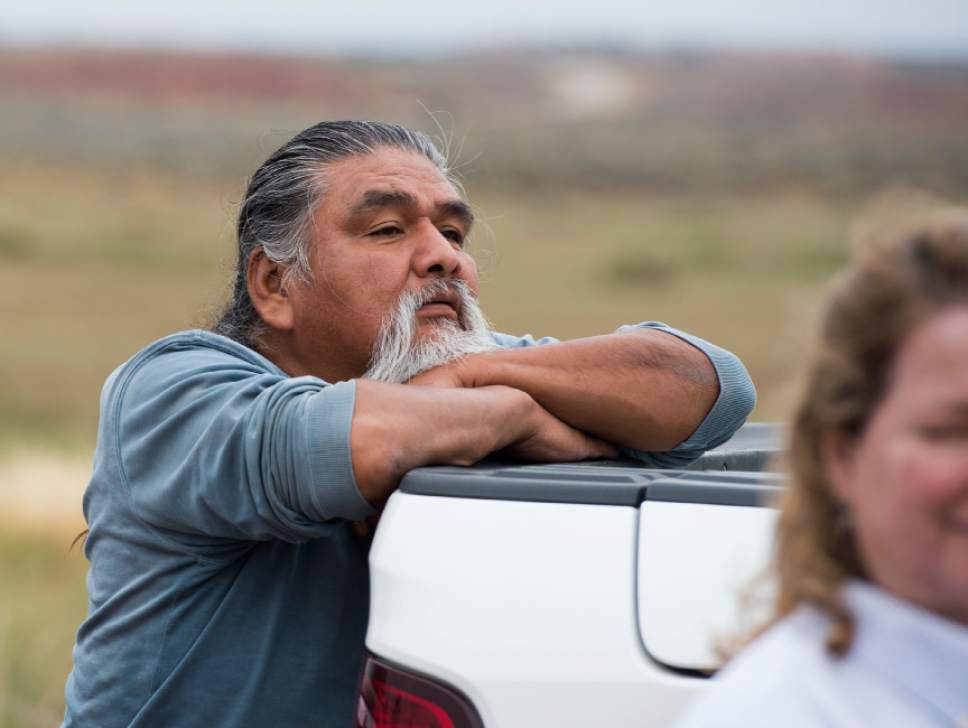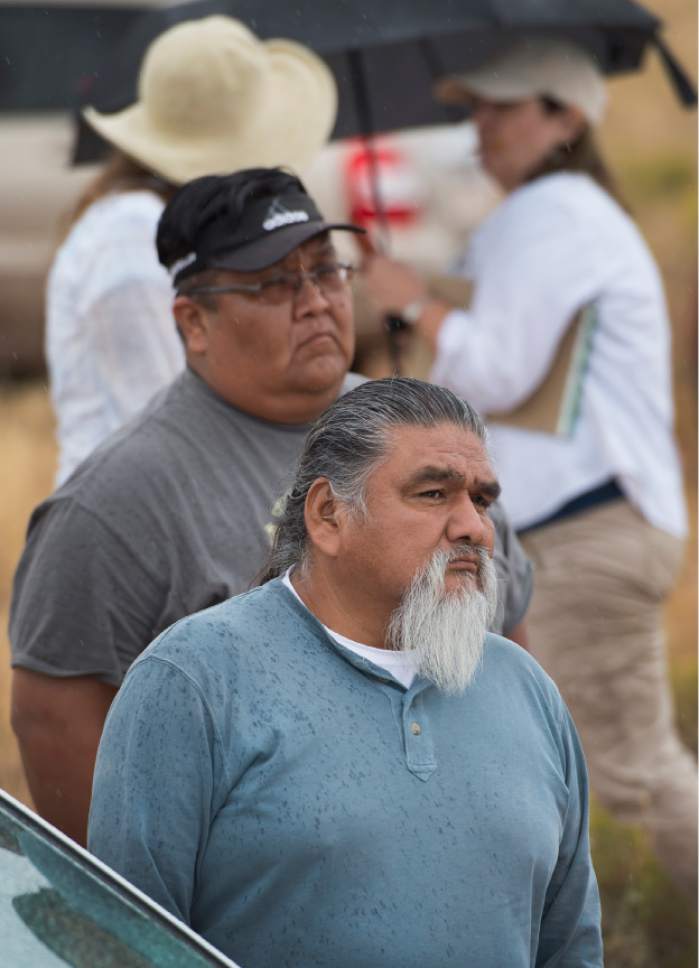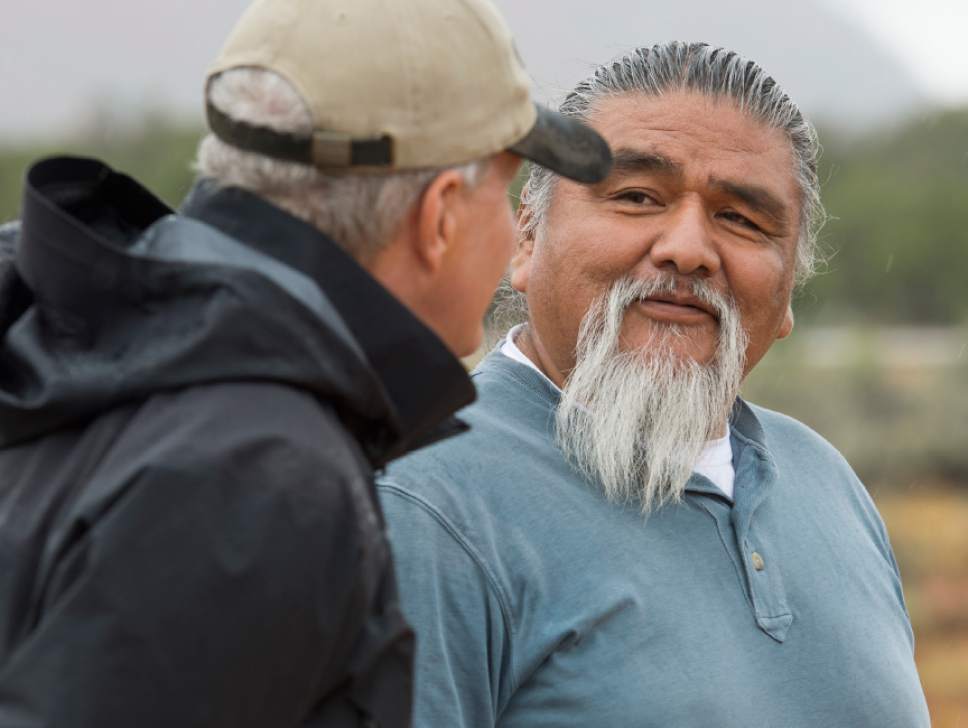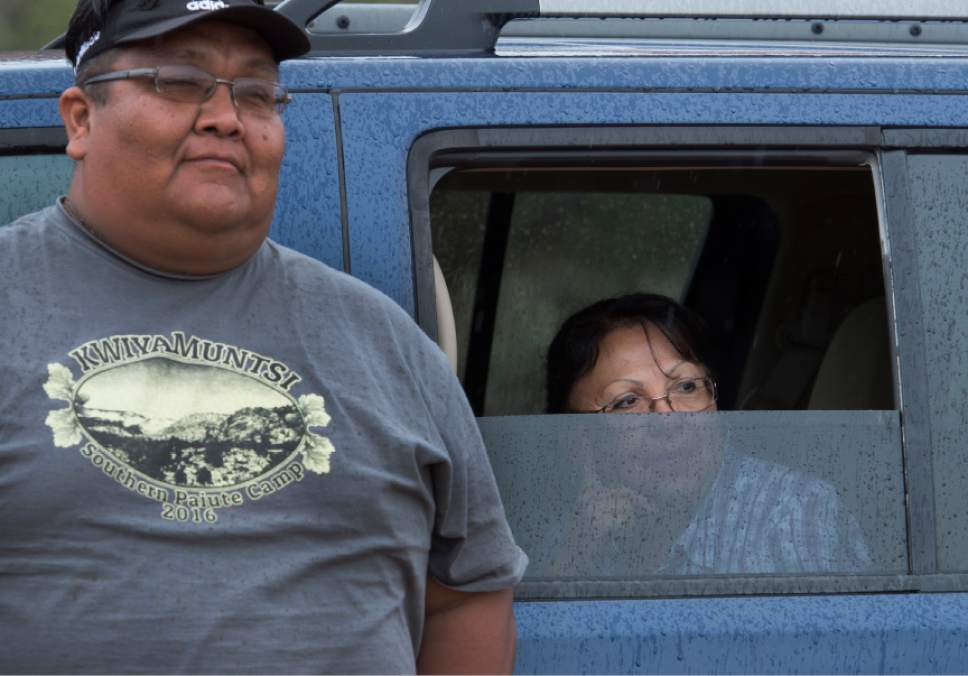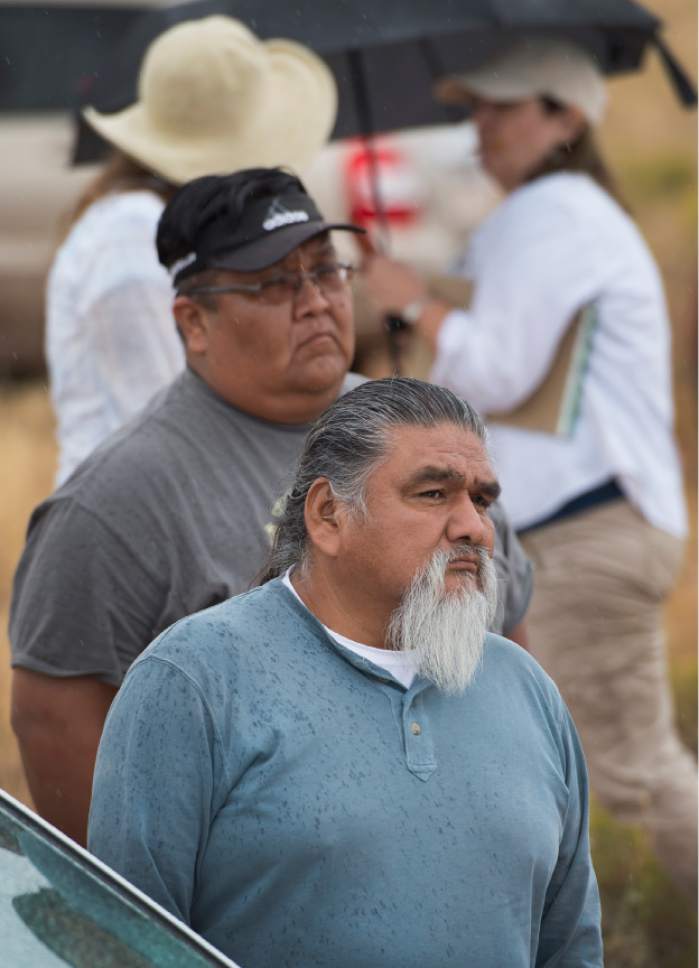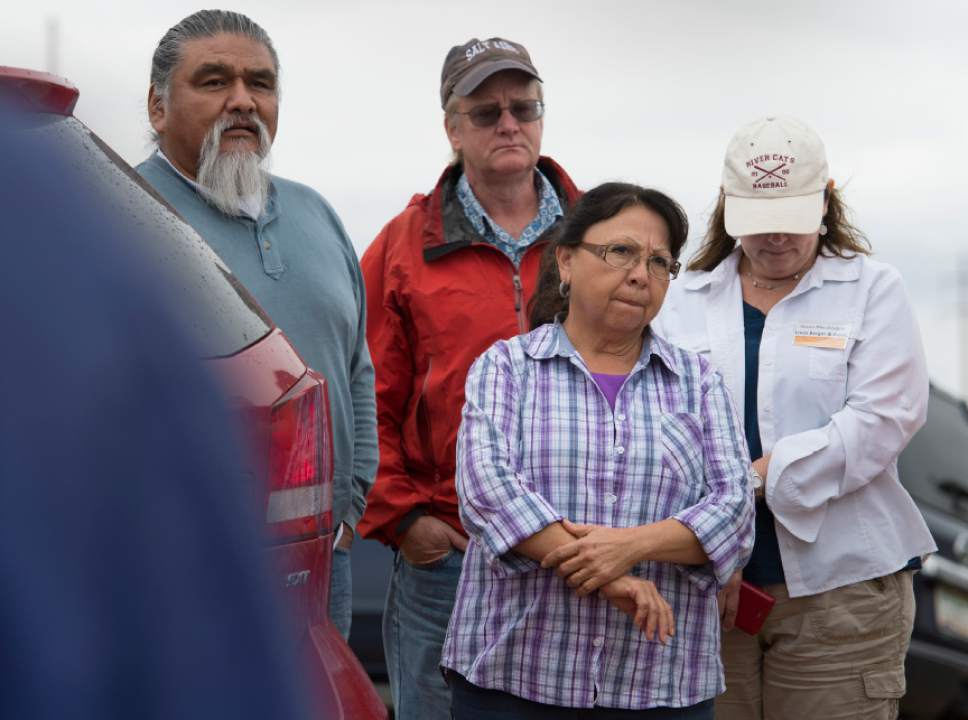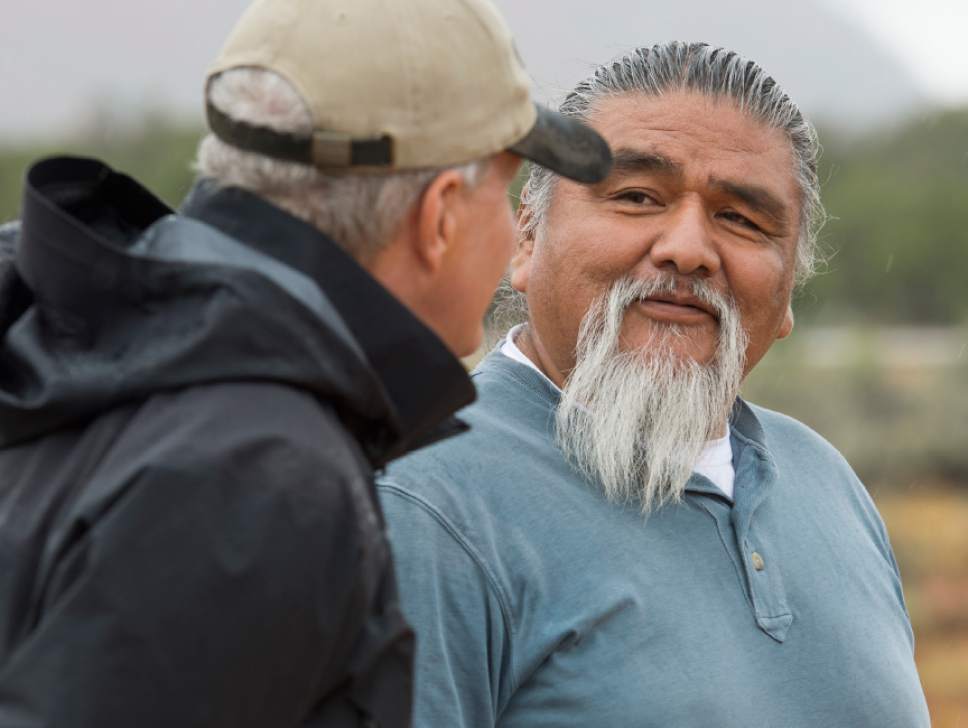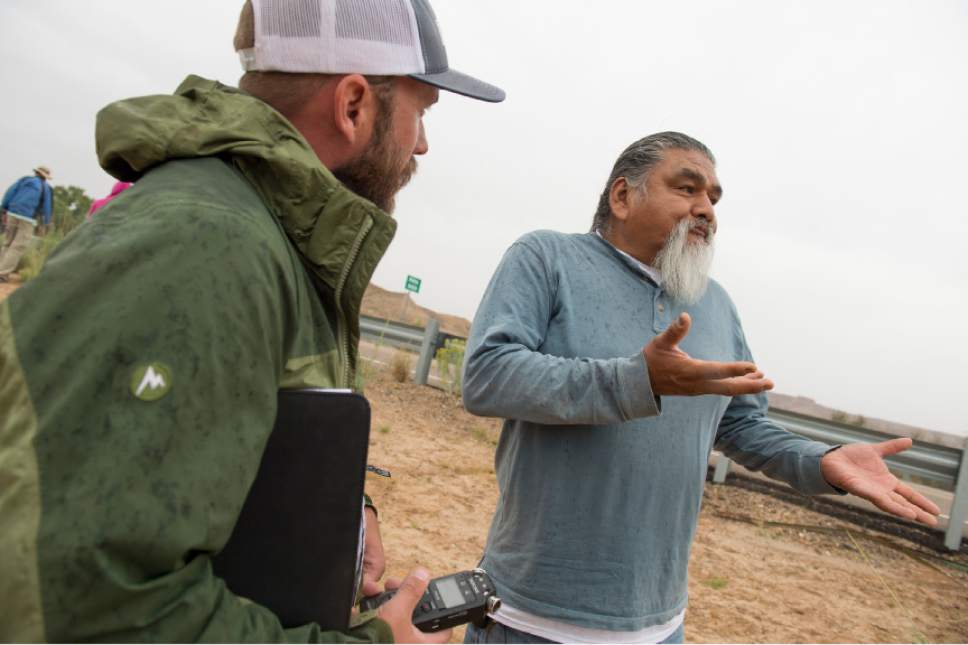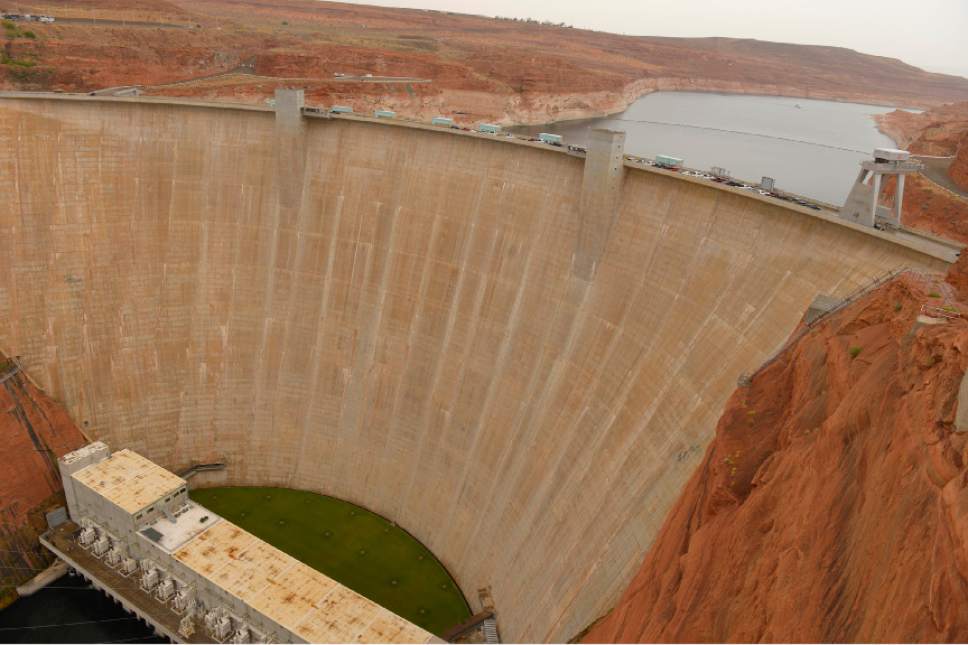Leah Hogsten | The Salt Lake Tribune
Federal Energy Regulatory Commission (FERC) officials Jim Fargo, left, and Frank Winchell l
Leah Hogsten | The Salt Lake Tribune
Officials from the Federal Energy Regulatory Commission (FERC) began a two-day site visit i
Leah Hogsten | The Salt Lake Tribune
Kaibab Band of Paiute Indians tribal chairman Roland Maldonado and tribe elder Glendora Ho
Leah Hogsten | The Salt Lake Tribune
"It's all so frustrating," said Kaibab Band of Paiute Indians tribal chairman Rol
Leah Hogsten | The Salt Lake Tribune
Kaibab Band of Paiute Indians tribal chairman Roland Maldonado, front, and Daniel Bulletts
Leah Hogsten | The Salt Lake Tribune
Kaibab Band of Paiute Indians tribal environmental director Daniel Bulletts and tribe elde
Leah Hogsten | The Salt Lake Tribune
Kaibab Band of Paiute Indians tribal chairman Roland Maldonado talks with MWH Global's eng
Leah Hogsten | The Salt Lake Tribune
Kaibab Band of Paiute Indians tribal environmental director Daniel Bulletts and tribe elde
Leah Hogsten | The Salt Lake Tribune
Kaibab Band of Paiute Indians tribal chairman Roland Maldonado, front, and Daniel Bulletts
Leah Hogsten | The Salt Lake Tribune
Kaibab Band of Paiute Indians tribal chairman Roland Maldonado and tribe elder Glendora Ho
Leah Hogsten | The Salt Lake Tribune
"It's all so frustrating," said Kaibab Band of Paiute Indians tribal chairman Rol
Leah Hogsten | The Salt Lake Tribune
Kaibab Band of Paiute Indians tribal chairman Roland Maldonado talks with MWH Global's eng
Leah Hogsten | The Salt Lake Tribune
"It's all so frustrating," said Kaibab Band of Paiute Indians tribal chairman Rol
Leah Hogsten | The Salt Lake Tribune
"It's all so frustrating," said Kaibab Band of Paiute Indians tribal chairman Rol
Leah Hogsten | The Salt Lake Tribune
Officials from the Federal Energy Regulatory Commission (FERC) visited Utah in September 20
Leah Hogsten | The Salt Lake Tribune
Federal Energy Regulatory Commission (FERC) officials Jim Fargo, left, and Frank Winchell laugh with Brian Liming of MWH Global, an engineering consulting firm on the Lake Powell Pipeline project, during a tour on Tuesday. Officials from the FERC began a two-day site visit in southern Utah Tuesday, Sept. 20, 2016, examining the 139-mile route of the proposed Lake Powell Pipeline.
Leah Hogsten | The Salt Lake Tribune
Officials from the Federal Energy Regulatory Commission (FERC) began a two-day site visit in southern Utah on Tuesday, September 20, 2016, examining the 139-mile route of the proposed Lake Powell Pipeline. During the public tour, FERC looked at the pipeline's planned hydropower stations, proposed alignment and the environment the pipeline would cross.
Leah Hogsten | The Salt Lake Tribune
Kaibab Band of Paiute Indians tribal chairman Roland Maldonado and tribe elder Glendora Homer listen as a representative with MWH Global's engineering firm details the proposed route for the proposed Lake Powell Pipeline (LPP). The LPP will cut through the Kaibab Band of Paiute's reservation in one of two proposed routes and the tribe favors limiting damage to undisturbed sacred sites. Officials from the Federal Energy Regulatory Commission (FERC) began a two-day site visit in southern Utah Tuesday, examining the 139-mile route of the proposed Lake Powell Pipeline, September 20, 2016. The public tour was so that FERC could view the pipeline's planned hydropower stations, proposed alignment and the environment the pipeline will cross.
Leah Hogsten | The Salt Lake Tribune
"It's all so frustrating," said Kaibab Band of Paiute Indians tribal chairman Roland Maldonado while talking about the proposed Lake Powell Pipeline (LPP). The LPP will cut through the Kaibab Band of Paiute's reservation in one of two proposed routes and Maldonado said the tribe favors limiting damage to undisturbed sacred sites. Officials from the Federal Energy Regulatory Commission (FERC) began a two-day site visit in southern Utah Tuesday, examining the 139-mile route of the proposed Lake Powell Pipeline, September 20, 2016. The public tour was so that FERC could view the pipeline's planned hydropower stations, proposed alignment and the environment the pipeline will cross.
Leah Hogsten | The Salt Lake Tribune
Kaibab Band of Paiute Indians tribal chairman Roland Maldonado, front, and Daniel Bulletts, tribal environmental director listen as a representative with MWH Global's engineering firm details the proposed route for the proposed Lake Powell Pipeline (LPP). The LPP will cut through the Kaibab Band of Paiute's reservation in one of two proposed routes and Maldonado said the tribe favors limiting damage to undisturbed sacred sites. Officials from the Federal Energy Regulatory Commission (FERC) began a two-day site visit in southern Utah Tuesday, examining the 139-mile route of the proposed Lake Powell Pipeline, September 20, 2016. The public tour was so that FERC could view the pipeline's planned hydropower stations, proposed alignment and the environment the pipeline will cross.
Leah Hogsten | The Salt Lake Tribune
Kaibab Band of Paiute Indians tribal environmental director Daniel Bulletts and tribe elder Glendora Homer listen as a representative from MWH Global's engineering firm details the proposed route for the proposed Lake Powell Pipeline (LPP). The LPP will cut through the Kaibab Band of Paiute's reservation in one of two proposed routes and the tribe favors limiting damage to undisturbed sacred sites. Officials from the Federal Energy Regulatory Commission (FERC) began a two-day site visit in southern Utah Tuesday, examining the 139-mile route of the proposed Lake Powell Pipeline, September 20, 2016. The public tour was so that FERC could view the pipeline's planned hydropower stations, proposed alignment and the environment the pipeline will cross.
Leah Hogsten | The Salt Lake Tribune
Kaibab Band of Paiute Indians tribal chairman Roland Maldonado talks with MWH Global's engineering firm representative Brian Liming, who detailed the proposed route for the proposed Lake Powell Pipeline (LPP) September 20, 2016. The LPP will cut through the Kaibab Band of Paiute's reservation in one of two proposed routes and Maldonado said the tribe favors limiting damage to undisturbed sacred sites. Officials from the Federal Energy Regulatory Commission (FERC) were led on a two-day site visit in southern Utah Tuesday, to examine the 139-mile route of the proposed Lake Powell Pipeline, September 20, 2016. The public tour was so that FERC could view the pipeline's planned hydropower stations, proposed alignment and the environment the pipeline will cross.
Leah Hogsten | The Salt Lake Tribune
Kaibab Band of Paiute Indians tribal environmental director Daniel Bulletts and tribe elder Glendora Homer listen as a representative from MWH Global's engineering firm details the proposed route for the proposed Lake Powell Pipeline (LPP). The LPP will cut through the Kaibab Band of Paiute's reservation in one of two proposed routes and the tribe favors limiting damage to undisturbed sacred sites. Officials from the Federal Energy Regulatory Commission (FERC) began a two-day site visit in southern Utah Tuesday, examining the 139-mile route of the proposed Lake Powell Pipeline, September 20, 2016. The public tour was so that FERC could view the pipeline's planned hydropower stations, proposed alignment and the environment the pipeline will cross.
Leah Hogsten | The Salt Lake Tribune
Kaibab Band of Paiute Indians tribal chairman Roland Maldonado, front, and Daniel Bulletts, tribal environmental director listen as a representative with MWH Global's engineering firm details the proposed route for the proposed Lake Powell Pipeline (LPP). The LPP will cut through the Kaibab Band of Paiute's reservation in one of two proposed routes and Maldonado said the tribe favors limiting damage to undisturbed sacred sites. Officials from the Federal Energy Regulatory Commission (FERC) began a two-day site visit in southern Utah Tuesday, examining the 139-mile route of the proposed Lake Powell Pipeline, September 20, 2016. The public tour was so that FERC could view the pipeline's planned hydropower stations, proposed alignment and the environment the pipeline will cross.
Leah Hogsten | The Salt Lake Tribune
Kaibab Band of Paiute Indians tribal chairman Roland Maldonado and tribe elder Glendora Homer listen as a representative with MWH Global's engineering firm details the proposed route for the proposed Lake Powell Pipeline (LPP). The LPP will cut through the Kaibab Band of Paiute's reservation in one of two proposed routes and the tribe favors limiting damage to undisturbed sacred sites. Officials from the Federal Energy Regulatory Commission (FERC) began a two-day site visit in southern Utah Tuesday, examining the 139-mile route of the proposed Lake Powell Pipeline, September 20, 2016. The public tour was so that FERC could view the pipeline's planned hydropower stations, proposed alignment and the environment the pipeline will cross.
Leah Hogsten | The Salt Lake Tribune
"It's all so frustrating," said Kaibab Band of Paiute Indians tribal chairman Roland Maldonado, right, while talking about the proposed Lake Powell Pipeline (LPP) with Utah Rivers Council conservation director Nick Schou. The LPP will cut through the Kaibab Band of Paiute's reservation in one of two proposed routes and Maldonado said the tribe favors limiting damage to undisturbed sacred sites. Officials from the Federal Energy Regulatory Commission (FERC) began a two-day site visit in southern Utah Tuesday, examining the 139-mile route of the proposed Lake Powell Pipeline, September 20, 2016. The public tour was so that FERC could view the pipeline's planned hydropower stations, proposed alignment and the environment the pipeline will cross.
Leah Hogsten | The Salt Lake Tribune
Kaibab Band of Paiute Indians tribal chairman Roland Maldonado talks with MWH Global's engineering firm representative Brian Liming, who detailed the proposed route for the proposed Lake Powell Pipeline (LPP) September 20, 2016. The LPP will cut through the Kaibab Band of Paiute's reservation in one of two proposed routes and Maldonado said the tribe favors limiting damage to undisturbed sacred sites. Officials from the Federal Energy Regulatory Commission (FERC) were led on a two-day site visit in southern Utah Tuesday, to examine the 139-mile route of the proposed Lake Powell Pipeline, September 20, 2016. The public tour was so that FERC could view the pipeline's planned hydropower stations, proposed alignment and the environment the pipeline will cross.
Leah Hogsten | The Salt Lake Tribune
"It's all so frustrating," said Kaibab Band of Paiute Indians tribal chairman Roland Maldonado while talking about the proposed Lake Powell Pipeline (LPP). The LPP will cut through the Kaibab Band of Paiute's reservation in one of two proposed routes and Maldonado said the tribe favors limiting damage to undisturbed sacred sites. Officials from the Federal Energy Regulatory Commission (FERC) began a two-day site visit in southern Utah Tuesday, examining the 139-mile route of the proposed Lake Powell Pipeline, September 20, 2016. The public tour was so that FERC could view the pipeline's planned hydropower stations, proposed alignment and the environment the pipeline will cross.
Leah Hogsten | The Salt Lake Tribune
"It's all so frustrating," said Kaibab Band of Paiute Indians tribal chairman Roland Maldonado, right, while talking about the proposed Lake Powell Pipeline (LPP) with Utah Rivers Council conservation director Nick Schou. The LPP will cut through the Kaibab Band of Paiute's reservation in one of two proposed routes and Maldonado said the tribe favors limiting damage to undisturbed sacred sites. Officials from the Federal Energy Regulatory Commission (FERC) began a two-day site visit in southern Utah Tuesday, examining the 139-mile route of the proposed Lake Powell Pipeline, September 20, 2016. The public tour was so that FERC could view the pipeline's planned hydropower stations, proposed alignment and the environment the pipeline will cross.
Leah Hogsten | The Salt Lake Tribune
Officials from the Federal Energy Regulatory Commission (FERC) visited Utah in September 2016, examining the 139-mile route of the proposed Lake Powell Pipeline. The public tour was so that FERC could view the pipeline's planned hydropower stations, proposed alignment and the environment the pipeline will cross.


